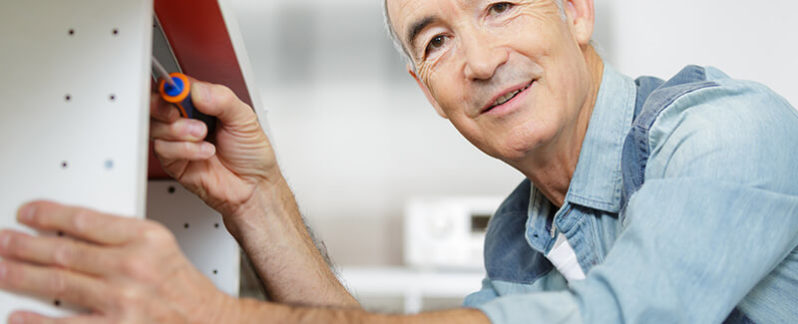
Budget-Friendly Remodeling Tips for Aging in Place
July 26, 2020 | Family Life
There is little doubt, the pandemic has changed all of our lives in unexpected ways. As an alternative to moving, seniors are considering budget-minded remodeling projects to continue to live comfortably and safely in their homes.
In some states, skilled nursing and assisted-living facilities have put new occupancies on hold until the pandemic is over. That means that much of our elderly population has no choice but to make the best out of their current situation, as hard as that might be.
Whether you or your loved desire to age in place or are waiting for a parent to enter an assisted living or skilled nursing facility, these budget-minded remodeling ideas are things you can do to ensure an elderly family member or friend is situated comfortably and safely in their home.
Precautions to Take Before Starting
Renovation work, no matter how simple, always comes with its list of hazards. However, we’re currently operating amid a pandemic so there are a few more things to consider to ensure everyone working and living in the home is safe.
If you or your family member want to roll up your sleeves and help with a budget-minded remodeling project, don’t get in over your heads. For some seniors, it would be more appropriate to find a comfortable spot to observe the commotion.
Directing from afar as the foreman could work in some instances. Either way, remember, to ask about key decisions like paint color or furniture placement.
Be Safety-Conscious Throughout
Friend, family, or neighbor; it doesn’t matter. Ensure you follow proper COVID protocol by having everyone wear a mask, stay socially distant, and wash their hands. Most of all, disinfect any surfaces you’ve worked with prior to leaving for the day.
Call in a Professional, If Needed
Most of these tips are simple to do on your own. However, things like insulating a home, while keeping a budget-minded remodeling project in mind, should be handled by a professional contractor. Know when to defer to a professional, bonded contractor’s expertise!
Other areas where it makes sense to consult a professional is with an interior designer who has experience in Universal Design. Before you begin your project here are some of the principles of Universal Design for aging in place: flexibility in use, simple and intuitive use, and low physical effort.
For example, one of the easiest things you can do is to replace doorknobs with levers. Also, trade out traditional faucets for models with blade handles or motion controls.
Renovate the Bathroom: Make it Slip-Proof and Accessible
The first line item in a budget-minded remodeling task list is safety. The most dangerous place in an elderly person’s house is the bathroom. Think about it; it’s all slick surfaces, often wet, with nowhere to catch yourself or fall safely should a slip occur.
Make the bathroom remodel a fun project and find a good balance between practical and tasteful so your family member or friend has something to be proud of. While you redo the bathroom, make the following changes to make it a safer space:
Install Grab Bars
Grab bars come in many shapes and sizes. They’re also inexpensive and easy to install. Put a bar in the bathtub and/or shower as well as next to the toilet. Try making it a collaboration—have the homeowner walk through the bathroom and show you where they’d like a bar.
Make the Floor Non-skid
We’ve all slipped on a slick floor! It can happen to anyone at any age, but it’s exceptionally dangerous to an elderly person. You can buy non-skid adhesive strips, which can be applied in the tub and on the floor. For something more elegant you might even want to consider an area rug that adheres to the floor.
Rework the Tub Situation
Bathtubs, in general, are not accessible and can be the most common reason an elderly person slips and falls in the bathroom. Look into a shower seat, install non-skid strips, and make ample use of grab bars. While it’s decidedly not budget-friendly, you could even consider a fancy walk-in bathtub. Yes—it’s a thing and it would make a bathroom feel like a spa!
Increase Curb Appeal While Decreasing Hazards
One of the easiest ways to reinvigorate a home is by upgrading its curb appeal. Curb appeal is what a home looks like from the outside (from the curb) and it’s often the first impression! There are plenty of things you can do to upgrade the exterior while making the entrance a safer and more accessible place.
Install a Ramp
Steps are incredibly dangerous, even in fair weather. If your elderly person uses a walker, cane, or wheelchair you may consider replacing the steps entirely and installing a ramp instead. Just make sure the ramp is non-skid and, above all else, make sure someone is clearing it of snow and ice in the winter!
Fix Uneven Pavement
A cracked and uneven sidewalk or front walk can be a tripping hazard. If it’s been a while since either has seen some TLC it might be time to redo them. Don’t forget to look into fun things like solar walkway lights, stone boundaries, or planted boundaries to give the new entryway an upgrade.
Rehab the Porch
One of the best things you can on a summer day is to sit out on your front porch and people watch from a safe distance. If the porch is cluttered or lacks comfortable seating, then you have the perfect opportunity to do a quick and easy redesign of that space. Consider installing a screen to keep bugs away or even a ceiling fan if you live in a hot climate.
Explore The Power of Minimalist Living
Marie Kondo asked it best; “Does this spark joy in your life?” The truth is, we’re all guilty of living with a little too much! Minimizing your elderly family member or friend’s “stuff” can go a long way to making them more comfortable and safer. Keep in mind, your goal is to help your loved one downsize possessions; it will make moving into a smaller space easier when the day comes.
De-clutter their Space
You’d be surprised by the treasure hidden in the drawers and inside boxes of a person that has led a long and happy life. Make your de-cluttering efforts fun by focusing on the great stuff you find while getting rid of the superfluous things that are taking up space.
Offer to take photos of items that create clutter but hold special remembrances. Photos and notes can be turned into a photo book on sites like Blurb or Shutterfly.
Reduce the Amount of Furniture
Furniture is a safety hazard with elderly individuals who are not steady on their feet. Work on reducing the amount of furniture while keeping the space comfortable and retaining its personality. However, be mindful of how your friend or family member feels about these choices.
If your loved one is really attached to their things (which elderly people often are) offer to put their belongings in a secure, climate-controlled storage unit to give them peace of mind.
Rethink Appliances
Take a look at the kitchen. Are there kitchen appliances that are, perhaps, unsafe if your family member or friend used them on their own? Microwaves are good options for seniors and select models feature simpler controls and brighter interfaces. If in the budget, consider switching to an induction cooktop.
Since induction cooking does not use a flame or radiant heat to cook food, the cooktops remain cool to the touch reducing the possibility of an accidental burn or fire.
Place the washer and dryer on top of a storage pedestal to alleviate bending and reaching. Undertaking a budget-minded remodeling project includes things a lot of research to find the best appliance models that meet your needs. For example, is there a refrigerator model that features a higher bulb wattage to make the interior brighter so it’s easier to find things.
Redo Insulation, Windows, & Doors: It Might Be Subsidized
A comfortable home is a home that is well-insulated. After all, the purpose of insulation is to keep cool or warm air inside, depending on the season. Research energy assistance grants; the National Council on Aging (NCOA) has many programs available to insulate and/or weatherize a home inexpensively for those seniors that are considered low-income.
Low-Income Energy Assistance Program
LIHEAP is a federally funded program that provides grants to states, territories, the District of Columbia, and tribes to assist qualified individuals with their home heating and cooling costs.
Weatherization Assistance Program
WAP enables low-income families to permanently reduce their energy bills by making their homes more energy-efficient. Assistance is available regardless of whether a person owns or rents, lives in a single-family home, multi-family housing complex, or mobile home. The U.S. Department of Energy provides funding to states, U.S. overseas territories, and Indian tribal governments, which manage the day-to-day details of the program.
Keep it All Downstairs
A survey by The American Institute of Architects (AIA) finds increasing demand for single-level home designs, not just among older Americans, but Baby Boomers as well. One-level homes provide greater accessibility and are generally more cost-effective—benefits that appeal to busy people of all ages.
Single-level living is ideal
Single-level living is the best option for seniors of all ages. Steps can be a nuisance and at times, even a danger to the elderly. While it’s relatively affordable to put a ramp on their front entrance, it’s not as feasible to make the second story of a home accessible.
If your family member or friend suffers from mobility issues, then it might be simpler to repurpose a guest bedroom, home office, or formal dining room into a bedroom to keep everything they need downstairs where they can easily reach it.
Make everything they need easy to find
Working with one floor of a home isn’t as bad as it might seem. Have fun with giving the first floor a renewed importance. Turn it into a mini-home that your family member or friend can be proud of.
Make the basement off-limits, too
The basement is just as dangerous (if not more so) than the second floor for someone with mobility issues. If your family member or friend’s laundry is in the basement, consider bringing it into the kitchen or bathroom if there’s space. In homes without basements, these are the two rooms that most commonly house the washer and dryer anyway.
Remodels are Something to Be Excited About
While it’s important to focus on how much money to spend on a budget-minded remodeling project it’s equally important to be aware of possible hazards and the age of your family member or friend. Instead, frame your projects as remodels—make it fun, give everyone something to be excited about, and get working!
If you need assistance in clearing out clutter, excess furniture, or other items that may get in the way of remodeling, Metro Self Storage has the space you need. Find a location near you today!



